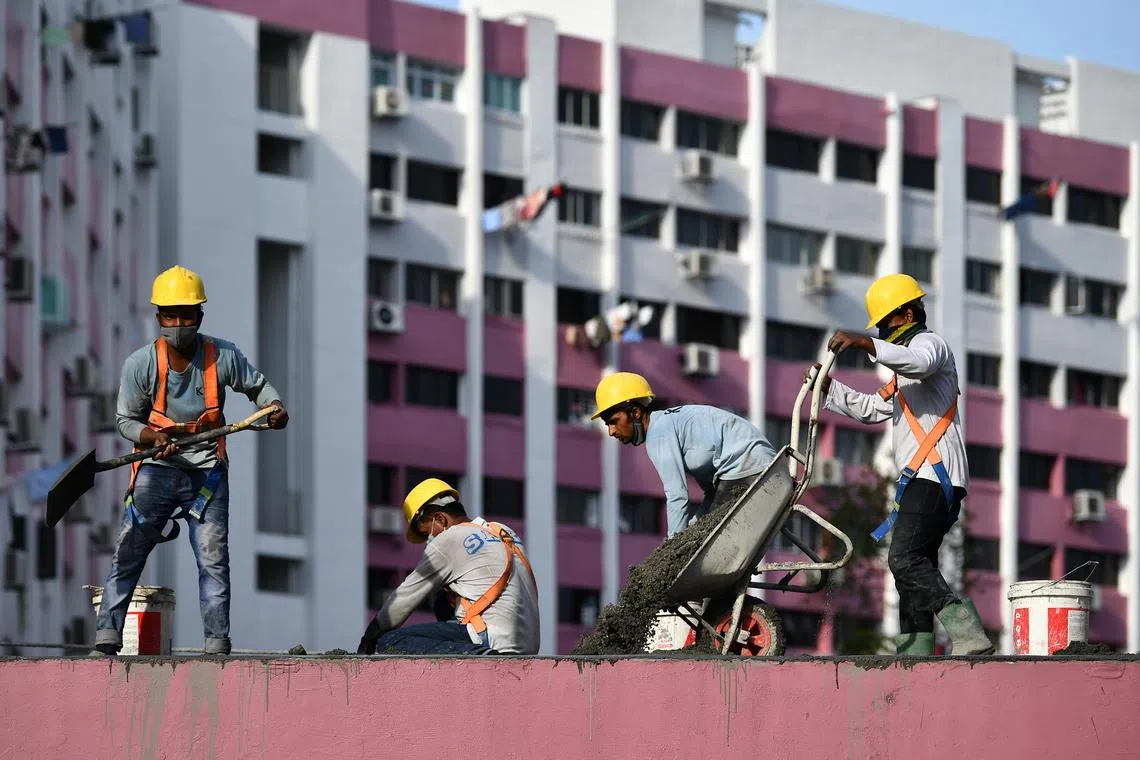About 1 in 3 workplaces inspected from March to June breached heat safety rules: MOM
Sign up now: Get ST's newsletters delivered to your inbox

High heat stress levels increase the risks of heatstroke, heat exhaustion and heat cramps.
ST PHOTO: LIM YAOHUI
Follow topic:
SINGAPORE – Out of 250 workplaces inspected between March and June, about 30 per cent were found to have breached heat safety rules during these hottest months of the year, when recorded temperatures on certain days exceeded 36 deg C.
At 78 worksites, employees were not given adequate rest breaks under shade for heavy physical work, or were not put through heat acclimatisation programmes, among other contraventions, the Ministry of Manpower (MOM), which conducted the inspections, said in mid-July in response to media queries.
Those workplaces included construction sites, shipyards, process plants and landscaping sites.
MOM said it took enforcement measures such as imposing fines and issuing notices of non-compliance, and the companies have since put in place the required heat safety measures.
The targeted inspections between March and June were the first since enhanced measures to reduce heat stress for outdoor workers were announced in October 2023.
Under the new measures, outdoor workers should get hourly rest breaks during periods of moderate or high heat stress, which is defined using the Wet Bulb Globe Temperature (WBGT).
The WBGT measures how heat affects humans, taking into account the effects of humidity, air temperature, wind speed and solar radiation.
For example, those doing heavy physical work outdoors should get 15 minutes of rest every hour when WBGT readings are 33 deg C or higher, indicating high heat stress.
Other measures include shifting outdoor work to cooler parts of the day and having scheduled hydration sessions.
High heat stress levels increase the risks of heatstroke, heat exhaustion and heat cramps.
The months from March to June are some of the warmest of the year.
In 2024, this period mostly coincided with the El Nino climate phenomenon, which brought drier, hotter conditions to South-east Asia and Australia.
Failing to establish a heat acclimatisation programme – or a regime to get workers slowly accustomed to working in hot conditions – was one of the lapses in some of the 78 companies revealed by the MOM inspection.
Acclimatisation involves gradually exposing employees to Singapore’s heat and humidity, and increasing the duration and intensity of outdoor work over at least seven days.
For example, a worker could do two hours of work outdoors on his first two days at work, while avoiding the hottest hours. He can spend the rest of the working day doing light tasks indoors.
This is particularly crucial for foreign workers who hail from cooler climates, and those who return from prolonged leave or have recovered from longer-term illness.
Acclimatisation is not a new concept. The authorities have required employers to put in place such regimes since 2010. Enforcement actions can be taken against employers found not to have implemented them, said MOM.
The ministry added that over the past five years, the number of reported work-related heat disorder cases, such as those involving heatstroke or exhaustion, remained relatively low, affecting five or fewer workers each year, with one death reported in 2020.
Back then, a lifting supervisor, who had a pre-existing medical condition, succumbed to heatstroke on his first day at work after the two-month circuit breaker due to Covid-19.
He had lifting duties under the sun in the afternoon, and the worksite did not have a hydration programme in place for workers. This case was highlighted in a 2023 presentation published on the Workplace Safety and Health Council’s website.
The presentation also outlined other common instances of non-compliance observed at worksites. Those include placing water points under the sun and not having emergency response procedures for heat injury cases.
But MOM acknowledged that generally, most companies have the required heat stress measures in place.
“Some companies have also gone beyond the required measures to provide ice slurry or cold isotonic drinks for their workers,” the ministry said.
MOM has also been gathering feedback on the enhanced heat stress measures announced in October 2023, and will provide an update on the measures later in 2024.
Associate Professor Jason Lee, from the National University of Singapore’s Yong Loo Lin School of Medicine, said: “Focusing solely on heat disorder cases as an outcome measure overlooks the far-reaching impacts (heat has) on productivity, decision-making and workers’ morale.
“In our hot and humid climate, workers paid by the hour will naturally self-regulate their work pace to avoid heat exhaustion, leading to significant losses in productivity.”
Prolonged thermal discomfort also impairs decision-making and increases the risk of near misses and accidents, added Prof Lee, who leads Project HeatSafe, a local research initiative investigating how rising temperatures affect the health and productivity of people in South-east Asia.
The project calculated that in 2018, heat strain caused an 11.3 per cent decline in average productivity across the country’s four big economic sectors – services, construction, manufacturing and agriculture.
This percentage is forecast to increase to 14 per cent in 2035, causing an economy-wide output loss of $2.22 billion.
“By understanding the value of enhanced heat measures, employers can recognise that prioritising workers’ health and morale is not only ethical but also profitable. Good health and morale makes for good business,” added Prof Lee.
On July 25, UN Secretary-General Antonio Guterres warned that humanity is suffering from an “extreme heat epidemic”, calling for action to protect vulnerable groups and step up safeguards for workers.
In an accompanying report, the UN called for better access to, and a scaling up of, low-carbon cooling methods, as 2.4 billion workers worldwide are being exposed to excessive heat.


